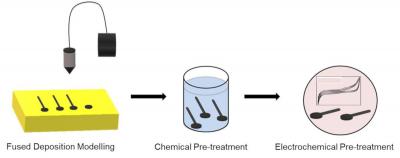A team of researchers from Nanyang Technological University, University of Chemistry and Technology Prague, and the King Saud University have 3D printed graphene-based electrodes capable of detecting mycotoxin zearalenone (aka ZEA, poisonous secondary metabolites) in food. The scientists believe their study could pave the way for a novel method of food safety assurance.

According to the study, contaminated products can lead to cancer or even death in humans. For this reason, timely and reliable methods of detecting mycotoxins are crucial for food inspectors to mitigate the spread and keep the products in food storage facilities safe until they reach the shelf.
The 3D printed electrodes were compared to a standard set of Ag/AgCl electrodes and while they were not as electroactive, the graphene set still did a fairly good job of detecting ZEA. The researchers calculated a respectable linear response of r=0.995 over a wide range of ZEA concentrations (10 300µM). Ultimately, the team concluded that their work was suitable for a proof-of-concept, opening up a great number of possibilities for research studies focused on 3D printing electrochemical devices for food safety and analysis.
The 3D printing of precise electrodes for sensor applications is becoming easier and easier with advancements in 3D printing technology. Earlier this year, a team of U.S. researchers 3D printed a working carbon monoxide detector with 3D inkjet printed silver electrodes. Upon testing the detector, the researchers found that it was able to function at room temperature with a fast response time. Elsewhere, in Korea, researchers 3D printed a set of highly sensitive, wearable biosensors.